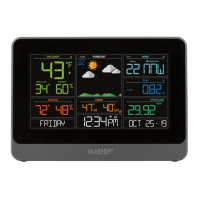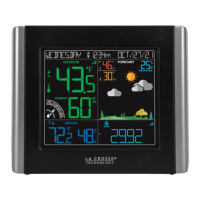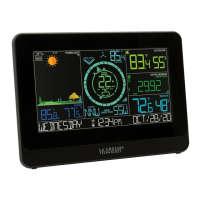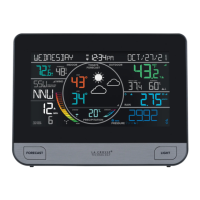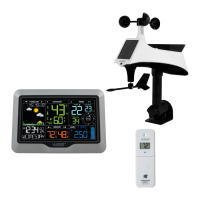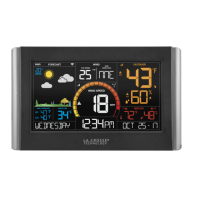22 | Page
• If you regain connection while the sensor is mounted, great. If you do not regain
connection, bring the sensor within 10 feet of the station and search again.
WIND INTERMITTANT: WHY DO MY WIND READINGS COME AND GO?
• RF (radio frequency) communication may come and go occasionally. This can be normal in
some environments (e.g. moister climates).
• If a sensor goes out, please wait 2-4 hours for it to reconnect on its own. Please be patient
– these stations can reconnect on, after many hours out.
• RF (radio frequency) communication is not always 100% on. Certain temporary conditions
can cause it to go out for a time (e.g. 100% humidity).
• If your wind sensor loses connection to the station for any reason, the station will show
dashes after 30 minutes.
• The station will search for 5 minutes every hour to reconnect with wind sensor.
• Be sure you have good batteries. Manually search for your sensor.
• Bring your wind sensor within 10 feet of your station and make sure it is connected to the
station.
• After 15 minutes move the wind sensor into the next room with a wall between the sensor
and the station for 1 hour.
• If there is no loss of signal in that hour, move the wind sensor just outside.
• Continue moving the wind sensor back to its original location.
• If you lose connection, look for sources of interference.
WIND ACCURACY: WHY IS MY WIND SPEED INACCURATE?
• What are you comparing your wind speed to? Your local reporting station is miles from your
location and should not be used for comparison.
• Check the unit of measure (MPH, or KMH).
• Check to see if your station receives the same repetitive wind speed recording from the
sensor multiple times.
• Check that the cups turn freely.
• Check for obstructions that prevent clear wind flow to the cups.
• Check mounting. In most cases, the wind sensor needs to be 6 feet or more above the
highest point on the roof in order to clear nearby obstructions and read accurately. A 50-foot
clearance in all directions is best.
• It is helpful to send pictures of the sensor mounting, if you need to contact customer support.
RAIN DASHES: WHY ARE THERE DASHES FOR RAIN READINGS?
Dashes indicate the connection is lost between your station and the rain sensor.
• My first thought is always to check that my batteries are good. If it has been working and
now is not, low batteries are the most common connection problem.
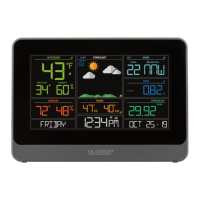
